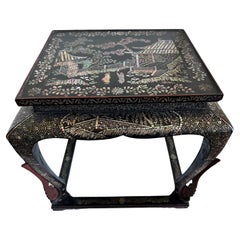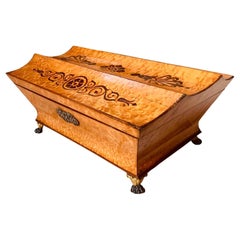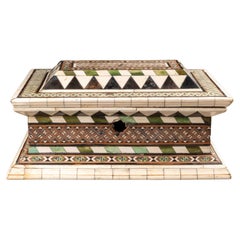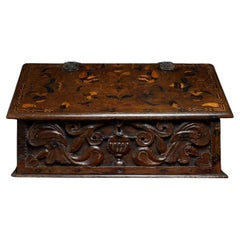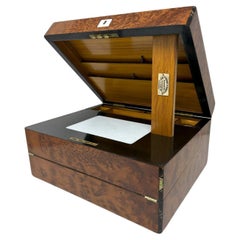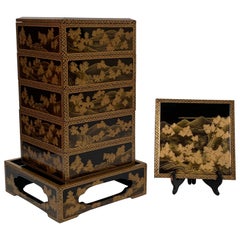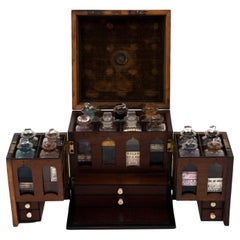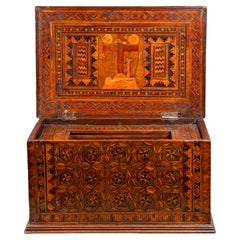Inlay Decorative Boxes
25
to
1
16
7
25
25
25
5
2
1
1
1
25
206
151
79
44
63
25
9
2
3
3
3
2
9
9
4
5
Height
to
Width
to
19
11
8
6
5
16
9
9
7
5
Period: 18th Century and Earlier
Technique: Inlay
American Walnut Satinwood Inlaid Valuables Box with Original Feet, Circa 1780
Located in Hollywood, SC
American Chippendale walnut oval satinwood inlaid valuables box with a carved molded hinged lid revealing an interior till with a secret hidden drawer, e...
Category
1780s American Chippendale Antique Inlay Decorative Boxes
Materials
Satinwood, Walnut
Antique Japanese Lacquer and Inlay Kang Table from Ryukyu Island
Located in Atlanta, GA
A small low table with lacquer and intricate mother-of-pearl inlay design from Ryukyu Islands kingdom circa 17-18th century. Ryukyuan kingdom was used to be an independent island cou...
Category
18th Century Japanese Edo Antique Inlay Decorative Boxes
Materials
Mother-of-Pearl, Lacquer
Antique Japanese Lacquer and Inlay Table from Ryukyu Islands
Located in Atlanta, GA
A small square-form table with lacquer and intricate mother-of-pearl inlay design from Ryukyu Islands kingdom circa 17-18th century. Ryukyuan kingdom was used to be an independent is...
Category
18th Century Japanese Edo Antique Inlay Decorative Boxes
Materials
Mother-of-Pearl, Lacquer
Fine English Regency Period Bird’s Eye Maple Marquetry Box
Located in Free Union, VA
A very fine and exquisitely grained bird’s eye maple box of unusual form: the top curved into three concave channels, each one inlaid with contrast...
Category
Early 18th Century English Regency Antique Inlay Decorative Boxes
Materials
Birdseye Maple
Embriachi workshop marquetry casket - Northern Italy, 15th century
Located in Bruxelles, BE
Embriachi workshop marquetry casket
Northern Italy, 15th century
Alla certosina inlays (bone, stained bone, pewter and wood)
H 28.2 x W 18 x D 14 cm
This beautiful casket of rectangular form is richly decorated with the characteristic geometric patterns of the Embriachi style.
The intricate geometric patterns are fashioned by juxtaposing lighter and darker pieces of wood, (colored) bone, horn and pewter. The lid and base are framed by a broad band of horn. When ivory became scarce in Europe due to disrupted trade routes, bone was substituted.
The attention to Symmetry and balance created an harmonious visual effect
Enhancing the overall aesthetic appeal of the casket.
The application of geometrical motifs is in Italy known as marquetry ‘alla Certosina’, named after the Certosina Church in Pavia with its famous altarpiece decorated in this way. This is ‘intarsia technique’, a term derived from the Arabic 'tarsi', which means ‘incrustation' recalling ancient mosaics made from various materials.
These geometric elements not only enhance the aesthetic appeal of the caskets but also demonstrate the versatility and skill of the artisans in creating multifaceted works of art.
‘Alla Certosina’ became famous through the Northern Italian Embriachi family who achieved a particularly high standard in working in this technique. Venice in particular was known for the production of these luxurious boxes. The caskets, hexagonal or rectangular, surmounted by a lid decorated in several registers constitute the secular, albeit equally renowned component of the workshop’s production, in addition to mirror frames and various everyday objects.
The method of fabrication of those objects was based on two concepts that underlay pre-industrial production: standardization and modularity, thanks to a distribution of skills according to the different phases of fabrication.
even the realization of the marquetry motifs (in the form of ingots from which portions of the desired size were cut) were therefore entrusted to various specialized craftsmen, as were the assembly phase.
Today better known thanks to the extensive research work recently carried out by Michele Tomasi, this workshop owes its name to its founder and owner, the Florentine Baldassare Ubriachi (or degli Embriachi), a merchant and banker established in the Tuscan capital before he settled in Venice in 1395. Together with sculptor Giovanni di Jacopo, who directed the workshop, from the last years of the fourteenth century, Baldassare oversaw a production that was truly original, and still easily recognizable today, comprising monumental altarpieces and various objects, primarily triptychs and caskets.
The precise location of the workshop is unknown, except that it originated in Florence and in ca. 1431 there was apparently a workshop in Venice, in the area of S Luca. They employed local workers specializing in 'certosina' (inlay of stained woods, bone and horn), and the workshop produced items carved in bone (usually horse or ox) with wood and bone marquetry.
The geometric decoration of Embriachi caskets reflects the artistic complexity and attention to detail that characterized their work.
this inlaid casket is a testament to the skill and artistry of the Embriachi family and serves as a stunning example of the decorative arts of the late Middle Ages.
Related Literature :
E. Berger, Prunk-Kassetten: Europäischen Meisterwerke aus acht Jahrhunderten / Ornamental Caskets...
Category
15th Century and Earlier Italian Renaissance Antique Inlay Decorative Boxes
Materials
Pewter
17th Century, Charles I, Inlaid & Carved Oak Desk Box, Circa 1640
Located in Leominster, GB
The top board bearing marquetry-inlaid initials ‘MA’, the slope with further marquetry-inlaid flowers and meandering foliage, enclosing an interior with a shelf, the end boards boldl...
Category
17th Century English Jacobean Antique Inlay Decorative Boxes
Materials
Oak
Tea Caddy Yew Boxwood Inlaid English George III
Located in Cheltenham, GB
A fine 18th century satinwood and yew tea caddy, the oval burr panels figuring on all sides with boxwood banding and bone knob to the lid. Wonderful patination and remnants of silver...
Category
18th Century English Georgian Antique Inlay Decorative Boxes
Materials
Boxwood, Yew, Satinwood
Japanese Momoyama Period Black Lacquer and Mother of Pearl Box, 16th Century
Located in Austin, TX
A fine and unusual Japanese black lacquer and mother of pearl inlaid box, Momoyama Period, 16th century, Japan.
The large box and cover featu...
Category
16th Century Japanese Edo Antique Inlay Decorative Boxes
Materials
Lacquer, Abalone
18th Century French Straw Marquetry, 'Marqueterie de Paille' Work Box
Located in Stamford, CT
A beautiful 'as is' late 18th or early 19th century example of 'Marqueterie de Paille', or straw marquetry, work box. The top inlaid with a wonderful cityscape, with early architectu...
Category
Late 18th Century French Neoclassical Antique Inlay Decorative Boxes
Materials
Straw
17th Century William and Mary Floral Marquetry Olive Oyster Lace Box, Circa 1685
Located in Oxfordshire, United Kingdom
A fine and rare 17th-century William and Mary olive oyster floral marquetry lace box, circa 1685. England
The cross grain olive moulded and holly banded top is centred by an oval of...
Category
17th Century English William and Mary Antique Inlay Decorative Boxes
Materials
Bone, Boxwood, Ebony, Oak, Olive, Tulipwood, Holly
18 C, Indo-Portuguese Vargueno Mini Cabinet
Located in Dallas, TX
Presenting a fabulously rare 18c Indo-Portuguese Vargueno mini cabinet.
Extremely rare, highly important and desirable colonial piece !
It is an In...
Category
Late 18th Century Indian Anglo-Indian Antique Inlay Decorative Boxes
Materials
Brass
18C Indo-Persian Campaign Vanity Box
Located in Dallas, TX
PRESENTING AN EXTREMELY RARE AND HIGHLY IMPORTANT Indo-Persian Campaign Vanity Box from circa 1780-1800.
Box inlaid with exquisite mosaic inlay.
In the Indo-Persian style of mosaic with Islamic styles.
The mosaic consists of green semi precious stone, bone, brass and pewter in star shaped geometric designs.
Box opens up to reveal a travel mirror...
Category
18th Century Indian Anglo-Indian Antique Inlay Decorative Boxes
Materials
Multi-gemstone, Brass
19th Century Manner of George Bullock, Regency Brass Inlaid Rosewood Lap Desk
Located in Morristown, NJ
c.1800, England, Regency brass inlaid rosewood lap desk in the manner of George Bullock. Rectangular box with double-hinged lid, opening to tooled navy leather and gold embossed writ...
Category
Early 18th Century English Regency Antique Inlay Decorative Boxes
Materials
Brass, Gold Leaf
17th/18th Century Italian Venetian Marquetry Table Box
Located in Forney, TX
An important early antique Italian Renaissance table box, handcrafted in Northern Italy in the 17th/18th century, cassone chest form, richly inlaid, the top and front panel with fruitwood banding framing...
Category
18th Century Italian Renaissance Antique Inlay Decorative Boxes
Materials
Wood, Fruitwood
17th Century Silver Mounted Traveling Box with Key
Located in Dallas, TX
A 17th century silver mounted Coromandel wood with mother of pearl inlay traveling box with a Interior fitted with drawers and a reliquary cabinet. W...
Category
17th Century French Antique Inlay Decorative Boxes
Materials
Silver
Antique Japanese Lacquer and Inlay Box from Ryukyu Island
Located in Atlanta, GA
A lacquer presentation box with mother-of-pearl inlays from Japanese Ryukyu Islands circa 17-18th century. The lidded box in rectangular form with rounded corner is a classic example...
Category
18th Century Japanese Japonisme Antique Inlay Decorative Boxes
Materials
Mother-of-Pearl, Lacquer
Large Japanese Namban Lacquer Coffer Arqueta, 16th Century
Located in Amsterdam, NL
A large Japanese Namban lacquer arqueta coffer for the Portuguese market
Kyoto, Momoyama-period, late 16th century
In Hinoki cypress lacquered in ...
Category
16th Century Japanese Antique Inlay Decorative Boxes
Materials
Mother-of-Pearl, Wood
English Georgian Inlaid Liquor Box with Six Original Bottles and Two Glasses
Located in Wells, ME
English Georgian domed top liquor box in mahogany with shell inlay to top and front and patterned stringing in boxwood and ebony to three sides and framing the shell inlays. The inte...
Category
Late 18th Century English Georgian Antique Inlay Decorative Boxes
Materials
Mahogany, Boxwood
English Georgian Double Tea Caddy with Boxwood Shell and Column Inlays
Located in Wells, ME
English Georgian double tea caddy in satinwood with oval panels inlaid with shaded boxwood shells, the front panels are facing shells and the top has a more elaborate frilly edged sh...
Category
Late 18th Century English George III Antique Inlay Decorative Boxes
Materials
Satinwood
Cherry wood and native wood box from the 18th century
Located in Beuzevillette, FR
Very large slurry box with parts in native wood veneer, marquetry nets and geometric decorations in marquetry on the top. The box rests on four arched feet in the Louis XV style.
Thi...
Category
Mid-18th Century French Louis XV Antique Inlay Decorative Boxes
Materials
Wood
Late 18th Century English George III Mahogany Knife Box Fitted Out for Letters
Located in San Francisco, CA
Late 18th century, English George III mahogany knife box fitted out for letters / ballots. The interior voided of the old knife compartments. One small remov...
Category
Late 18th Century English George III Antique Inlay Decorative Boxes
Materials
Metal
Rare 18th Century Parquetry Baroque Writing Slope, South Germany Circa 1760
Located in Ottawa, Ontario
The exterior surface decorated with striking geometric panels of contrasting light & dark fruitwood veneers with ebonized mouldings, the slant top opening on later iron hinges to a plain interior housing a small hinged compartment for writing implements...
Category
Mid-18th Century German Baroque Antique Inlay Decorative Boxes
Materials
Iron
Mexican Tortoiseshell and Pen-Engraved Cabinet
Located in Mexico, DF
Mexican cabinet. Made of tortoiseshell, pen-engraved and wood. Possible Oaxaca or Puebla, 17th century.
Category
17th Century North American Spanish Colonial Antique Inlay Decorative Boxes
Materials
Tortoise Shell
English Mahogany Satinwood Conch Shell Inlaid Wine Cellarette. Circa 1780
Located in Hollywood, SC
English mahogany wine cellarette with inlaid Satinwood conch shell, hinged top revealing a compartmentalized fitted interior, and terminating on the original turned legs with brass c...
Category
1780s English George III Antique Inlay Decorative Boxes
Materials
Brass
A late 15th century wood inlaid writing casket, Florence, Italy
Located in PARIS, FR
Florence, Italie
Late 15th century
Dimensions: h. 23 cm, w. 45cm, d. 29 cm
Walnut with inlays of different types of stained native wood
Rare writing box with intricate decoration of...
Category
15th Century and Earlier Italian Renaissance Antique Inlay Decorative Boxes
Materials
Walnut
Related Items
Antique Victorian Traveling Desk Birds Eye Maple Writing Slope Edwards Roberts
Located in Dublin, Ireland
An exceptionally fine quality early English well figured Birds Eye Maple Wood Ladies or Gents Travelling Writing Slope of outstanding quality and compact proportions. Last quarter of...
Category
19th Century English Victorian Antique Inlay Decorative Boxes
Materials
Brass
H 6.5 in W 13 in D 10.75 in
Japanese Maki-e Lacquer Stacking Box, Jubako, Meiji Period, Japan
Located in Austin, TX
A fine and impressive Japanese gold maki-e decorated black lacquer five-tier jubako with presentation tray, two lids, and the original tomobako storage box, Meiji period, late 19th c...
Category
Late 19th Century Japanese Meiji Antique Inlay Decorative Boxes
Materials
Lacquer
Stunning Faux Books Walnut & Satinwood Smoking Pipe Rack Holder with Drawers
Located in GB
We are delighted to offer this lovely Walnut & Satinwood Faux books pipe rack with internal drawers
A very good looking and decorative piece, its designed to hold three pipes in t...
Category
20th Century English Edwardian Inlay Decorative Boxes
Materials
Satinwood, Walnut
H 10.24 in W 8.27 in D 8.27 in
Small 17th Century, French Coffer or Box in Leather
Located in Buisson, FR
Extremely old box that is covered with leather and decorated with iron and brass.
Rare find.
France, circa 1600-1700
Weathered and some losses.
Category
17th Century French Antique Inlay Decorative Boxes
Materials
Iron
Japanese Momoyama Period Black Lacquer and Mother of Pearl Box, 16th Century
Located in Austin, TX
A fine and unusual Japanese black lacquer and mother of pearl inlaid box, Momoyama Period, 16th century, Japan.
The large box and cover featu...
Category
16th Century Japanese Edo Antique Inlay Decorative Boxes
Materials
Lacquer, Abalone
Thorens Swiss AD 30 Upright Music Box with Ten Discs, circa 1970
Located in Evergreen, CO
A quality fruitwood case with a glass door allows for viewing the metal discs that play on this upright music box by Thorens of Switzerland. The set ...
Category
1970s Swiss Vintage Inlay Decorative Boxes
Materials
Fruitwood
Circa 1830s English Regency to George IV Penwork Box
Located in Chapel Hill, NC
Circa 1830s English penwork box, Regency to George IV. Sarcophagus form; decorated with a large Asiatic panel with floral sides & borders. Replaced lion mask ring handles. Lacks inte...
Category
1830s English Regency Antique Inlay Decorative Boxes
Materials
Wood
Early 19th Century Regency Period Flame Mahogany Tea Caddy Box
Located in High Wycombe, GB
Regency period early 19th century flame mahogany tea caddy box with swing handle complete with an original hallmarked sterling silver George III tea caddy spoon
Comes with working key, item opens to reveal a fitted interior with twin caddies & central crystal mixing bowl which is a later addition.
A tea caddy is a box, jar, canister, or other receptacle used to store tea. When first introduced to Europe from Asia, tea was extremely expensive, and kept under lock and key. The containers used were often expensive and decorative, to fit in with the rest of a drawing-room or other reception room. Hot water was carried up from the kitchen, and the tea made by the mistress of the house, or under her supervision.
As the use of the jar waned and the box became more popular, the provision of different receptacles for green and black tea...
Category
19th Century British Regency Antique Inlay Decorative Boxes
Materials
Sterling Silver, Brass
Free Shipping
H 5.91 in W 11.82 in D 5.91 in
17th Century Nuremberg, German Iron Strongbox Jewels Casket
Located in Soquel, CA
Ornately painted cash box with iron hardware and key, on the original stand. Interior of box measures 8"W x 4"H x 3.75"D
Exceptional, small, late-renaissance, table-top, Nuremberg, iron, 'Wedding Box', strongbox or travelling safe with its original, naïve, painted decoration
This is a rare and small example of these characterful, early models of transportable safes. The much larger traditional chest...
Category
17th Century German Jacobean Antique Inlay Decorative Boxes
Materials
Wrought Iron, Iron
Classic Burl Walnut with Inlaid Brass Swiss Music Box
Located in Lambertville, NJ
This beautiful burl walnut music box with elegant brass inlaid top plays four different tunes. The rich sound resonated richly and has the workings made in Switzerland. The on and of...
Category
20th Century Swiss Inlay Decorative Boxes
Materials
Brass
19th English Regency Inlaid Jewelry Box
Located in Stamford, CT
19th century Regency jewelry bow with exquisite inlay of various woods, ebony, rosewood, fruit wood, walnut, mahogany. With intricate geometric pattern inlay throughout and start pat...
Category
Early 19th Century Regency Antique Inlay Decorative Boxes
Materials
Velvet, Ebony, Fruitwood, Mahogany, Walnut
Japanese Lacquer Hokai Box, 19th Century
Located in Pasadena, CA
This is a good example of a traditional Japanese Hokai shell storage box for the Kai-awase game. This box is well-detailed in chased brass appliques and makie. The box is in overall ...
Category
Late 19th Century Japanese Japonisme Antique Inlay Decorative Boxes
Materials
Wood, Lacquer
Previously Available Items
Georgian Satinwood Apothecary Box
Located in Northampton, GB
Complete with fifteen Glass Bottles
From our Apothecary collection, we are delighted to offer this Satinwood Apothecary Box. The Apothecary Box of square form veneered in Satinwood with fine Kingwood crossbanding and Boxwood edging finished with two bone escutcheons, one a dummy to finish exterior symmetry of the Box. The top of the box is fitted with a large brass circular carry handle allowing ease of travel and stands upon a slightly raised plinth base. The Apothecary Box opens from the top revealing the fifteen glass bottles with stoppers before opening forward and extending fully showing the two wings of the box with unusual almost gothic viewing windows for the bottle labels. The box contains 15 partitions for glass bottles, a velvet lined inner lid, six drawers which comprise of two large drawers and four smaller drawers. The drawers contain a selection of apothecary objects and a set of brass scales...
Category
Late 18th Century British George III Antique Inlay Decorative Boxes
Materials
Glass, Wood, Boxwood, Satinwood
A late 15th century wood inlaid writing casket, Florence, Italy
Located in PARIS, FR
Florence, Italie
Late 15th century
Dimensions: h. 23 cm, w. 45cm, d. 29 cm
Walnut with inlays of different types of stained native wood
Rare writing box with intricate decoration of...
Category
15th Century and Earlier Italian Renaissance Antique Inlay Decorative Boxes
Materials
Walnut
18C Anglo Indian Sadeli Mosaic Sarcophagus Sewing Box
Located in Dallas, TX
PRESENTING AN EXCEPTIONALLY RARE & IMPORTANT late 18C Anglo Indian Sadeli Mosaic Sarcophagus Sewing Box.
VERY, VERY EARLY Sadeli Mosaic piece, which is what makes it all the more important!
Made in the area of Bombay, India circa 1780-1800.
The box is in a classic Regency Era Sarcophagus form, very reminiscent of an Egyptian/Summarian Coffins/Tombs. This form features regularly in Tea Caddies of that period and helps us identify this piece as, most definitely, late 18th Century.
The box is flanked on either side by scroll shaped ends, with a raised platform on the lid.
The box is completely covered in an early version of ‘Sadeli Mosaic’.
It is edged/banded in faux ivory and ebony stringing.
The box case is made of sandalwood.
This box is a really EARLY example of this type of mosaic work.
The craftsmen of the Bombay area became famous for their ‘sadeli mosaic’ work, through the 19th Century and most examples of boxes with this mosaic, date from the mid-19th Century up to the early 20th Century.
As the surface of the early sadeli work, is quite rough/coarse to the touch, it was very difficult to maintain, as dusting with a cloth, would often ‘lift off’ some of the mosaic. Thus, very, very few pieces have survived fully intact.
There is no disputing that this box has lived a ‘full life’, BUT, that is to be expected of most Sadeli Mosaic pieces from 1880 … let alone one, from 100 years earlier than that!
It is remarkable that it has survived at all!
If this were in better condition, it would be in a museum and/or would have a VERY LARGE price tag of multiples of our asking price!
There has been quite a loss of mosaic and banding on the exterior, but the loss has been halted, by a gentle application of filler and clear lacquer.
The interior of the box is SUPERB, it is ‘pretty much’ in ORIGINAL CONDITION!
The mirror is the original and removeable. It is edged/banded with sadeli mosaic, bone and ebony.
It has a removeable base tray with various lidded compartments.
Original red velvet lining on the inside of the lid and under the tray.
The tray has 3 Sadeli mosaic lidded compartments (1 large and 2 small).
The ‘sadeli’ work on the lids, is exceptional and very well preserved, with only very minor losses. You can really see the quality of the original mosaic work on these!
It has a removeable pin cushion, banded in bone and hand decorated and the original burgundy velvet.
There are 4 bone lids for holding the 6 faux ivory thread spools, thimble, and hand decorated thread cannisters.
There is 1 long bone lid for storage underneath.
The interior is pretty much as good as it gets!
It sits on 4 brass ball feet.
THIS IS AN EXCEPTIONALLY RARE 18C MINIATURE SEWING BOX!
SADELI MOSAIC: “Anglo Indian boxes were made in India for the English residents from the early part of the 18th century. They were brought back or sent back to England usually by the people who had commissioned them. From the beginning of the nineteenth century they were imported more commercially, although not in any significant numbers until the middle decades. They were very highly valued, especially the early ones, to the extent that the designs were copied on late 19th and early 20th century tins.
The ancient art of Sadeli Mosaic is said to have been introduced from Shiraz in Persia via Sind to Bombay, a long time before the Anglo Indian boxes were made. It was a technique, which required a high degree of skill and patience. It was executed very lavishly, in that the frequent cuts wasted a great amount of the precious materials used. The workmanship was however more than commensurable to the value of the materials.
Ivory, silver, pewter (or other metals), wood and horn were cut into faceted rods which were bound together to form geometric patterns. When the glue has set, the rods were sliced in transverse sections. This gave the maker a number of angled circular pieces in the original pattern. Several variations of patterns could be achieved by combining the materials in different ways. The ivory was sometimes dyed green to give an extra color.
The mosaic pieces in a combination of patterns, often separated by ivory, ebony, horn or silver stringing were used to veneer sandalwood boxes. In the early boxes, which date from the turn of the 18th to the 19th century, there are large panels of mosaic covering tops and sides of boxes. It took incredible skill to cover such large areas without any shakes or wavering of the pattern. The corners and joins on these boxes are impeccably matched.
The makers (reputed to be Persian) of Sadeli mosaic made in the first two decades of the 19th century displayed a total understanding of the qualities of the different materials they used. They combined substances, which can expand and contract according to atmospheric conditions with others, which are hard and unyielding. The result was a sharp definition of the lines and patterns, which made up the whole design.
On the early boxes the designs look deceptively simple. The fact is, they emerged from a culture, which had mastered geometry and understood how to generate a pattern from a set number of points. The patterns are so harmoniously combined that their incredible complexity is not immediately apparent.
The earliest Sadeli boxes...
Category
Late 18th Century Indian Anglo-Indian Antique Inlay Decorative Boxes
Materials
Pewter
George I Rosewood Table/Spice Cabintet
Located in Folkestone, GB
A rare, early 18th cenury parquetry table top spice cabinet unusually veneered in rosewood set in a geometric pattern. The two doors opening to reveal an arrangement of seven drawers...
Category
Early 18th Century European George I Antique Inlay Decorative Boxes
Materials
Rosewood
Tea Caddy Mahogany Satinwood, Ebony, Rosewood Boxwood Inlaid English George III
Located in Cheltenham, GB
English George III triple tea caddy mahogany satinwood, ebony, rosewood and boxwood inlaid.
Satinwood, ebony, rosewood and boxwood tea caddy which dates to the end of the 18th century, with attractive fan inlaid...
Category
18th Century English Georgian Antique Inlay Decorative Boxes
Materials
Ebony, Mahogany, Boxwood, Rosewood, Satinwood
H 4.34 in W 7.49 in D 4.34 in
Josefinian Model Chest Of Drawers With Fine Marquetry, Vienna, ca 1770/1780
Located in Vienna, AT
Miniature furniture made by hand in high quality: spruce body, veneered with walnut and numerous precious woods, marquetry in the form of fields and bands, star inlay on the top, smooth surfaces, bevelled side edges on the front, small butt feet typical of the type, 3 full-length drawers, the top one with a lock, brass fittings, pull fittings with moving rings...
Category
1770s Austrian Louis XVI Antique Inlay Decorative Boxes
Materials
Fruitwood, Oak, Walnut
H 8.86 in W 14.38 in D 7.49 in
Josefinian Model Chest of Drawers with Fine Marquetry, Vienna, ca 1770
Located in Vienna, AT
Miniature furniture made by hand in high quality:
Oak body veneered with walnut and numerous fruitwoods, marquetry in the form of fields and strips, smooth surfaces with central pro...
Category
1770s Austrian Louis XVI Antique Inlay Decorative Boxes
Materials
Fruitwood, Oak, Walnut
H 10.52 in W 14.97 in D 8.15 in
English Regency Georgian Period Inlaid Mahogany Sarcophagus Tea Caddy
Located in Forney, TX
Classic refined elegance and sophistication at its finest.
Born at the turn of the late 18th / early 19th century, during the height of the golden age of English furniture and design, this Georgian period / Regency era (George III, 1760-1801) tea caddy with beautifully aged dark patina, features a rectangular sarcophagus-form case in warm, rich, highly figured mahogany veneer, accented by contrasting satinwood and ebony string banding and intricate cross-banded inlays, mounted with patinated metal lion's mask ring handles, raised on brass ball-and-claw feet.
The hinged lid top opens to reveal a visually striking interior, embellished with Chippendale old English fylfot rosette medallion, above a red upholstery lined center space that once housed a mixing glass...
Category
Late 18th Century English Georgian Antique Inlay Decorative Boxes
Materials
Metal, Brass
English Georgian Satinwood Double Tea Caddy with Burl Walnut Inlay
Located in Wells, ME
English George III satinwood double tea caddy with oval burl walnut inlays to all sides and the top. The kingwood crossbanding is enclosed by a thin line inlay of boxwood and is on a...
Category
Late 18th Century English George III Antique Inlay Decorative Boxes
Materials
Boxwood, Kingwood, Satinwood, Burl
English Georgian 18th Century Oval Satinwood Tea Caddy with Floral Inlays
Located in Wells, ME
English Georgian oval satinwood tea caddy with floral and leaf inlays in boxwood and sycamore to the front and sides. The lid is beautifully inlaid with a large shaded boxwood flower...
Category
Late 18th Century George III Antique Inlay Decorative Boxes
Materials
Satinwood, Sycamore, Boxwood
H 4.5 in W 5.75 in D 3.25 in
Early Antique English Satinwood Inlaid & Banded Mahogany Burl Canteen 18th C
Located in Big Flats, NY
An antique and early English canteen (cellarette) Colony Box offers English oak construction with Santo Domingo burl veneer, inlaid shell form marquetry reserves, banding, and hinged...
Category
18th Century English Antique Inlay Decorative Boxes
Materials
Mahogany
H 8.75 in W 11.25 in D 9 in
George III Mahogany Tea Caddy
Located in New York, NY
George III mahogany tea caddy,with shell & bird marquetry inlay.
Category
Late 18th Century English George III Antique Inlay Decorative Boxes
Materials
Mahogany
Recently Viewed
View AllMore Ways To Browse
Sevres Boxes
Sevres Box
Antique Hand Carved Wooden Box
Silver Box With Opening
Brass Trinket
Victorian Writing Box
Vintage Jewelry Trinket Box
Antique Brass Letters
Antique Marquetry Box
Midcentury Modern Trinket
Antique Secret Compartment Box
Baccarat Box
Antique Bottle Box
Antique Abalone
Chinese Wooden Boxes
Egg Plates Retro
Retro Egg Plate
Middle Eastern Inlaid


